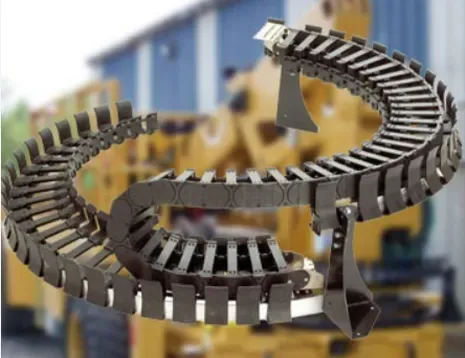cable drag chain
Understanding Cable Drag Chains Essential Components for Modern Machinery
In today’s industrial landscape, efficiency and safety are paramount. As machinery becomes increasingly sophisticated, the need for reliable and organized cable management systems has gained prominence. One such solution is the cable drag chain. This device plays a crucial role in ensuring that cables and hoses remain organized, protected, and functional within various machinery and equipment.
What is a Cable Drag Chain?
A cable drag chain, also known as a cable carrier or drag chain, is a flexible, modular system designed to guide and protect cables and hoses as they move in conjunction with machines. Commonly used in applications involving robotics, CNC machines, industrial conveyor systems, and other automated equipment, drag chains provide a reliable means of preventing cable wear and damage.
These chains consist of interconnected links or segments, which can open up to accommodate various types of cables and hoses. The design allows for movement in multiple dimensions while keeping the cables tidy and secure, even during high-speed operations.
The Importance of Cable Management
Effective cable management is crucial in preventing accidents and minimizing downtime in industrial environments. Cables left unmanaged can become tangled, leading to wear and tear, exposing them to potential damage from heat, abrasion, and motion. Additionally, disorganized cables can create hazards, posing risks to operators and leading to costly interruptions in production.
Cable drag chains address these concerns by providing a dedicated pathway for cables and hoses, thus enhancing safety and operational efficiency. By protecting cables from potential hazards and ensuring they move in harmony with machinery, drag chains contribute to longer cable lifespan and reduced maintenance costs.
cable drag chain

Applications of Cable Drag Chains
Cable drag chains find applications across various sectors. In manufacturing, they are employed in CNC machines to keep power and control cables organized and accessible. In automated warehousing systems, drag chains facilitate the smooth movement of conveyor belts by ensuring the safety of electrical and pneumatic lines.
Moreover, in robotics, where precise movements are essential, drag chains allow for unrestricted range of motion while protecting the integrity of cabling systems. This is particularly critical in applications that involve rapid movement or complex trajectories, where unmanaged cables could lead to operational failures.
Types of Cable Drag Chains
There are several types of cable drag chains available, each designed for specific applications and environments. Some are made from durable plastics, offering lightweight flexibility for lighter loads, while others are constructed from robust steel or aluminum for heavy-duty applications. Additionally, customizable drag chains can be adapted to fit a variety of specific needs, such as varying sizes, shapes, and load capacities.
Furthermore, drag chains can be designed for different environments, including those with high temperatures, chemical exposure, or cleanroom conditions. This versatility makes them suitable for a broad spectrum of industrial scenarios.
Conclusion
Cable drag chains are essential components in modern machinery, providing an efficient solution for cable and hose management. By ensuring that cables are organized, protected, and free-moving, drag chains contribute significantly to the safety and efficiency of industrial operations. As technology continues to evolve, the importance of effective cable management will only increase, making cable drag chains critical to the future of machinery and automation. Whether in robotics, manufacturing, or any specialized sector, investing in high-quality drag chains is a step towards enhanced operational integrity and safety.








